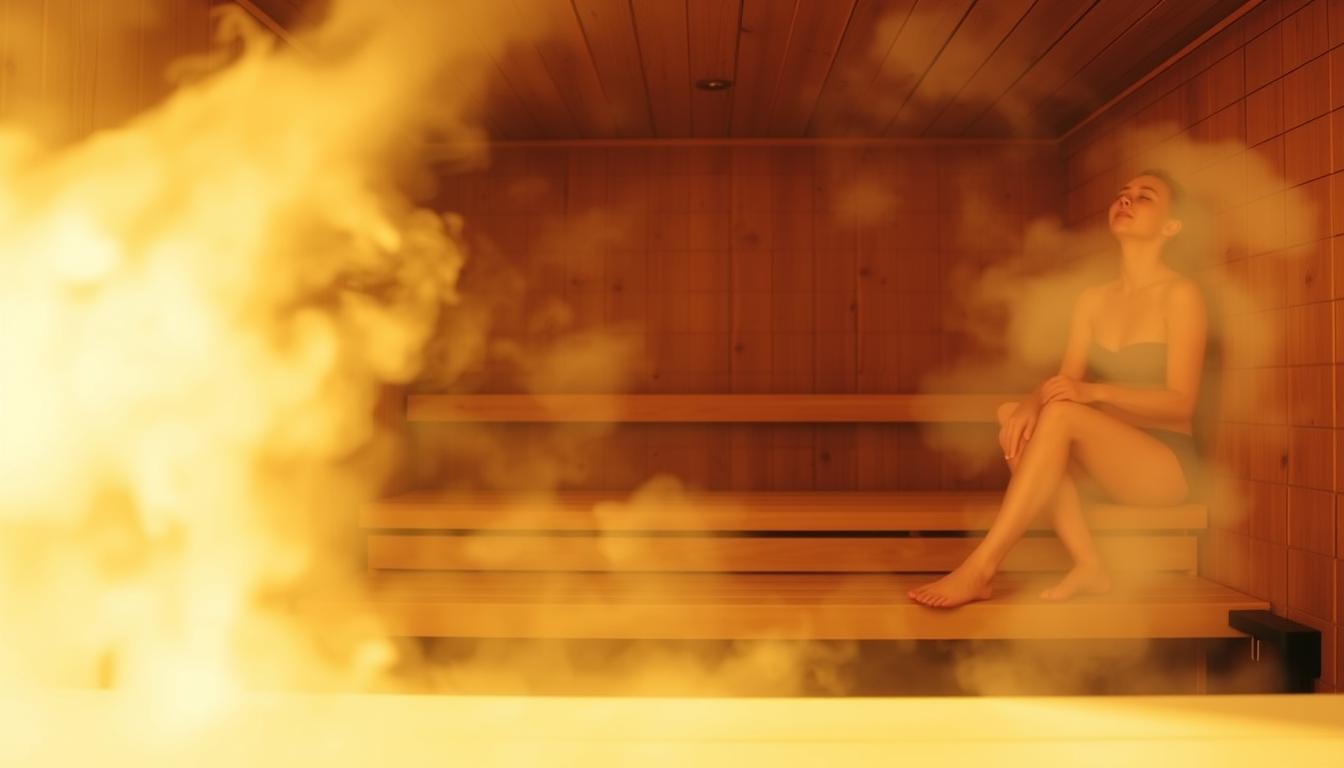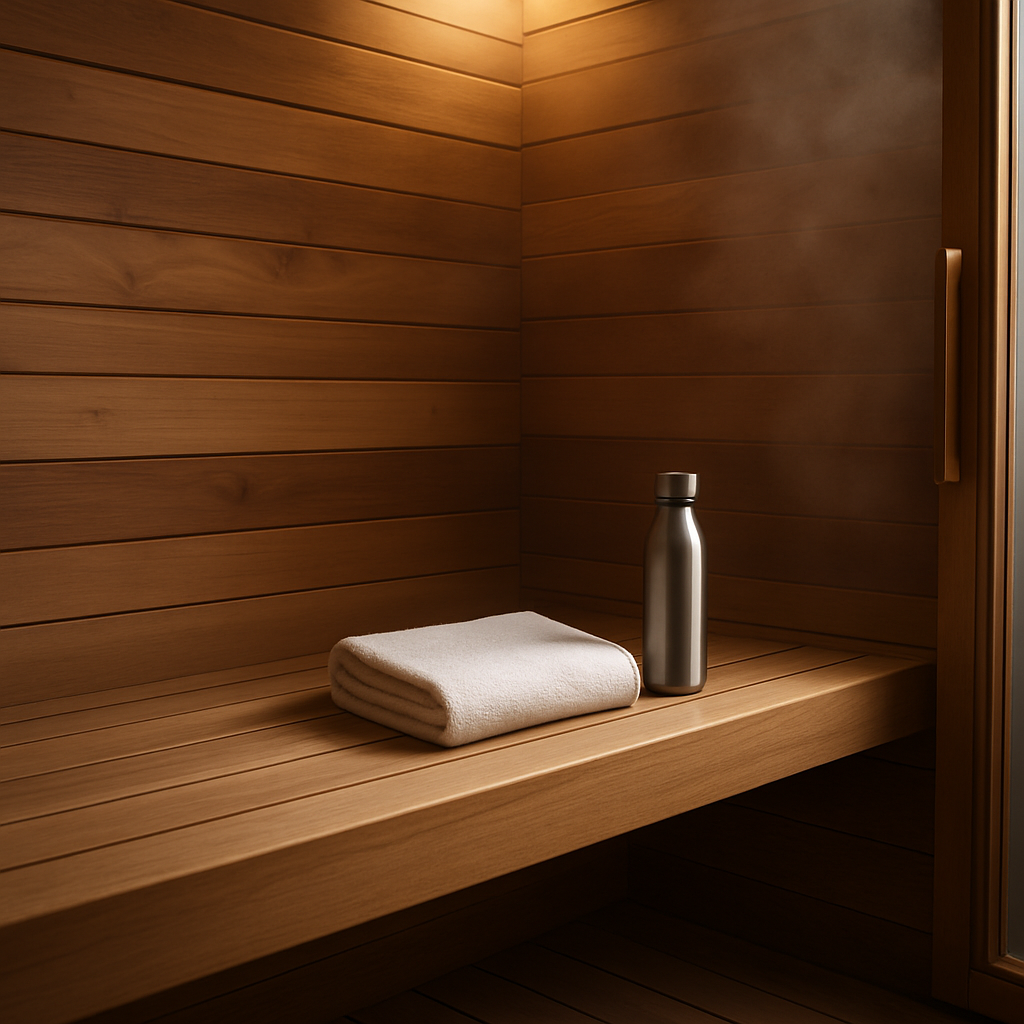
The Advantage of Sauna: Improve Your Wellbeing Naturally
Sauna therapy has become one of the hottest places to socialize while boosting your health. With a projected market growth of 151.3 million in the U.S. by 2029, more people are turning to this ancient practice for its natural wellness benefits.
Leading institutions like the Cleveland Clinic and Mayo Clinic, along with peer-reviewed studies, validate its effectiveness. From stress reduction to improved heart health, the benefits are backed by science.

Whether you’re looking to ease muscle pain or enhance cognitive function, sauna therapy offers a holistic approach to wellbeing. It’s more than just relaxation—it’s a lifestyle choice for better health.
Key Takeaways
- Sauna therapy is a natural way to improve overall health.
- Its popularity is growing, with significant market growth expected in the U.S.
- Trusted sources like the Cleveland Clinic and Mayo Clinic support its benefits.
- Key benefits include stress reduction and improved heart health.
- It also helps with pain relief and cognitive support.
Introduction to Sauna Therapy
From ancient traditions to modern wellness centers, saunas have stood the test of time as a health-boosting practice. These heated rooms, designed to induce therapeutic sweating, have been used for thousands of years to promote relaxation and wellbeing.
https://www.youtube.com/watch?v=7GJ92p4h-QE
What is a Sauna?
A sauna is a heated room typically maintained at temperatures between 158°F and 212°F. The primary goal is to create a space where the body can sweat, helping to detoxify and relax. There are two main types: dry heat, like in Finnish saunas, and wet heat, found in Turkish steam rooms.
Modern innovations include infrared saunas, which use light waves to penetrate deeper into tissues. As Dr. Tolentino explains, "Infrared generates body heat without external sources, making it a gentler option for many."
Historical Use of Saunas
Saunas have deep cultural roots. Traditional Finnish saunas have been used for over 2,000 years, and even today, one in three Finns regularly uses them. Similarly, Mayan sweat houses date back 3,000 years, showcasing the global appeal of heat therapy.
Over time, saunas have evolved from simple wood-burning designs to electric and infrared models. Today, they are a staple in wellness centers worldwide, blending ancient traditions with modern technology.
The Advantage of Sauna for Stress Reduction
Stepping into a heated room can do more than relax your muscles—it can calm your mind. Heat therapy has been shown to activate the parasympathetic nervous system, which helps your body unwind and recover. This process reduces cortisol levels, the hormone linked to stress, and promotes a sense of tranquility.

How Heat Therapy Calms the Mind
When exposed to heat, your body releases endorphins, often referred to as the "after-sauna glow." These natural mood boosters can help ease tension and improve your overall outlook. Dr. Zack explains, "The introspective time spent in a heated environment is similar to meditation, offering a mental reset."
Research supports this, with a 2024 study in Frontiers in Public Health showing that just 20-minute sessions can significantly reduce tension and depression scores. Additionally, frequent users report a 22% lower rate of depression, according to a Swedish survey.
Science Behind Heat and Anxiety
Heat exposure also triggers the release of BDNF, a protein that enhances mood regulation. This process may help alleviate anxiety and improve sleep quality. A study in Complementary Therapies in Medicine found an 83% improvement in sleep among participants who regularly used heat therapy.
However, it’s important to avoid pairing heat sessions with alcohol, despite the social tradition. Alcohol can dehydrate the body and counteract the benefits of heat therapy. Instead, focus on hydration and relaxation to maximize the stress-relieving effects.
Boosting Cardiovascular Health with Sauna Use
Regular heat sessions can significantly enhance your heart’s performance. Research shows that consistent exposure to heat can improve your cardiovascular health in multiple ways. From lowering blood pressure to increasing heart rate, the benefits are backed by science.
https://www.youtube.com/watch?v=7GJ92p4h-QE
Heart Rate and Blood Pressure Benefits
When you step into a heated room, your heart rate increases, similar to the effects of brisk walking. This mimics exercise, burning around 300 calories per hour. Dr. Parikh explains, "The cardiovascular load from heat therapy is comparable to moderate physical activity."
Heat-induced vasodilation also improves arterial flexibility. This process helps lower blood pressure over time. A 2025 Advances in Integral Medicine study found that regular heat exposure reduces diastolic blood pressure significantly.
Long-term Cardiovascular Effects
A Finnish 20-year study revealed that individuals who used heat therapy 4-7 times weekly had a 63% lower risk of cardiac death. Frequent users also experienced a 50% reduction in stroke risk, showcasing the long-term benefits of regular sauna use.
However, those with severe aortic stenosis should exercise caution. For others, incorporating post-sauna cool-down protocols can maximize benefits while ensuring safety.
Sauna Therapy for Pain Relief
Heat therapy offers a natural solution for easing discomfort and promoting recovery. Whether you’re dealing with chronic conditions or post-workout soreness, using sauna sessions can provide significant relief. Studies show that heat exposure activates the body’s natural healing processes, making it a valuable tool for pain management.

Chronic Pain Management
For those with chronic conditions like rheumatoid arthritis, heat therapy can be transformative. Research from the Cleveland Clinic highlights a 40% reduction in pain among patients who regularly use saunas. Infrared heat, in particular, has shown effectiveness in managing fibromyalgia symptoms, as noted in a 2009 meta-analysis by Beever et al.
Heat triggers the activation of opioid receptors in the body, which helps reduce pain perception. This process, combined with the release of BDNF protein, aids in muscle repair and recovery. For tension headaches, the relaxation of trapezius muscles during heat exposure can also provide relief.
Muscle Recovery and Relaxation
After intense strength training, a 15-minute sauna session can accelerate muscle recovery. The heat promotes blood flow, delivering essential nutrients to tired muscles. Adding Epsom salt steam can enhance the experience, further reducing inflammation and soreness.
Dry heat saunas are ideal for joint pain, while infrared options penetrate deeper for muscle-related discomfort. As Dr. Beever explains, "Infrared heat offers a gentler yet effective approach for those with sensitive conditions."
- Dry heat is best for joint and arthritis pain.
- Infrared heat targets deeper muscle layers.
- 15-minute sessions post-workout optimize recovery.
- Epsom salt steam enhances relaxation and reduces inflammation.
Improving Lung Function Through Sauna Use
Breathing easier can be a natural outcome of regular heat therapy. For those with respiratory conditions like asthma or COPD, sauna sessions may provide significant relief. The combination of heat and humidity can open airways, hydrate the respiratory mucosa, and improve overall lung function.

Benefits for Asthma and COPD
Heat exposure can lead to bronchodilation, which helps widen the airways. This is particularly beneficial for individuals with asthma or COPD. A Mayo Clinic trial found a 30% improvement in FEV1 (a measure of lung function) among COPD patients who used heat therapy regularly.
Dr. Zack notes,
"Wet saunas move mucus effectively, making them ideal for those with congestion."
However, asthmatics should avoid rapid temperature changes, as they may trigger symptoms.
How Saunas Enhance Respiratory Health
Heat therapy hydrates the respiratory mucosa, which can alleviate dryness and irritation. Steam saunas are especially effective for this purpose, as they add moisture to the air. For added benefits, consider using eucalyptus oil to help clear congestion.
A 12-week Finnish study found that regular sauna use reduced inhaler dependency among participants. Whether you choose dry or steam heat, the key is consistency. Here’s how to maximize the benefits:
- Use steam saunas for mucus-related conditions.
- Opt for dry heat if you prefer lower humidity.
- Add eucalyptus oil for enhanced congestion relief.
- Limit sessions to 15-20 minutes to avoid overheating.
Sauna Benefits for Skin Health
Your skin can reap significant rewards from regular heat therapy. From reducing acne to improving elasticity, the benefits are backed by science. Heat exposure stimulates circulation, promoting a natural glow and healthier complexion.
Managing Psoriasis and Other Skin Conditions
For those with psoriasis, heat therapy can be transformative. Research from the Dermatology Times shows that 44% of patients report reduced plaques after regular sessions. Steam, in particular, helps hydrate the skin and reduce inflammation.
Dr. Ilyas notes,
"Steam reduces acne sebum by 27%, making it an effective tool for clearer skin."
However, individuals with rosacea should approach heat therapy cautiously, as it may trigger flare-ups.
Improving Skin Elasticity and Glow
Induced sweating during heat sessions helps cleanse pores, removing dirt and impurities. This process, combined with increased circulation, boosts collagen production, enhancing skin elasticity.
For an added boost, pairing steam rooms with clay masks can amplify the detoxifying effects. A 2023 study in the Journal of Investigative Dermatology found that heat therapy reduces transepidermal water loss, keeping skin hydrated and radiant.
- Pore cleansing through sweating removes impurities.
- Increased circulation boosts collagen production.
- Clay masks in steam rooms enhance detoxification.
- Heat therapy reduces transepidermal water loss.
- Caution for rosacea patients to avoid heat triggers.
Sauna Use and Immune System Support
Regular exposure to heat can activate your body’s defenses, helping you stay healthier year-round. Studies show that heat therapy may help strengthen your immune system, reducing the risk of common illnesses like colds and infections.

Preventing Common Colds and Infections
Frequent sauna users report fewer colds, according to a study by the Munich School of Medicine. The research found a 41% reduction in colds among participants who used heat therapy regularly. This is likely due to the activation of heat shock proteins, which mimic the body’s natural fever response and enhance immunity.
Heat exposure also increases white blood cell (WBC) counts, which play a key role in fighting infections. As Dr. Schmidt explains,
"The artificial fever response triggered by heat therapy can help your body prepare for real infections."
Reducing Inflammatory Markers
Chronic inflammation is linked to many diseases, but heat therapy can help. A study in the Journal of Human Kinetics found that regular sauna use lowers IL-6, a key inflammatory marker, by 17%. This reduction may help protect against conditions like heart disease and arthritis.
However, it’s important to avoid heat sessions during active infections. While heat therapy can boost immunity, it may worsen symptoms if you’re already sick. Instead, consider using saunas as part of a post-flu reactivation protocol to rebuild your defenses.
- Heat shock proteins mimic the body’s fever response.
- Increased WBC counts help fight infections.
- Lower IL-6 levels reduce chronic inflammation.
- Post-flu sauna sessions can aid recovery.
- Avoid heat therapy during active infections.
While the benefits are promising, research is needed to fully understand how heat therapy impacts long-term immunity. For now, incorporating regular sauna sessions into your routine may help keep your immune system strong.
Sauna Therapy for Better Sleep
Unwinding in a heated space can transform your nightly routine. Heat therapy has been shown to improve sleep quality by helping your body relax and prepare for rest. Whether you struggle with falling asleep or staying asleep, a regular sauna session might be the solution you’ve been looking for.

How Saunas Promote Relaxation
When you step into a heated room, your core temperature rises. As your body cools down afterward, it triggers the release of melatonin, the hormone responsible for sleep. This natural process helps you fall asleep faster and stay asleep longer.
Dr. Li explains,
"The drop in core temperature after a sauna session mimics the body’s natural sleep cycle, promoting deeper rest."
For best results, schedule your session 2-3 hours before bedtime. This allows your body to cool down gradually, enhancing the sleep-inducing effects.
Research on Sauna Use and Sleep Quality
A study published in Sleep Medicine Reviews found that heat therapy can reduce sleep onset by 19%. Additionally, it increases slow-wave sleep, the deepest stage of rest, by 23%. This means more restorative sleep and better overall health.
Fitbit data also supports these findings, showing a 34-minute increase in REM sleep among regular sauna users. For an added boost, try chamomile-infused steam during your session. Its calming properties can further enhance relaxation.
- Core temperature drop triggers melatonin release.
- Evening sessions 2-3 hours before bed optimize sleep benefits.
- Chamomile-infused steam adds a calming touch.
- Heat therapy increases slow-wave and REM sleep.
Sauna and Cognitive Health
Heat therapy isn’t just for the body—it’s a boost for the brain too. Studies show that regular exposure to heat can enhance cognitive function and even reduce the risk of conditions like Alzheimer disease. From memory to focus, the benefits are backed by science.
Reducing Risk of Dementia and Alzheimer’s
Heat therapy may help protect your brain from cognitive decline. A 2016 study by Laukkanen found that individuals who used heat sessions 4-7 times weekly had a 65% lower risk of Alzheimer disease. This is partly due to heat’s ability to break down amyloid plaques, which are linked to dementia.
Dr. Laukkanen explains,
"Heat exposure increases the production of heat shock proteins, which help protect brain cells from damage."
This process may slow the progression of neurodegenerative diseases.
Improving Cognitive Function
Heat sessions can also sharpen your mind. Harvard Health research shows that BDNF (brain-derived neurotrophic factor) increases by up to 142% after heat exposure. This protein supports memory, learning, and overall brain health.
For adults over 55, heat therapy has been linked to improved verbal fluency. Pairing sessions with activities like crossword puzzles can further enhance cognitive benefits. Additionally, individuals with ADHD may find that heat therapy improves focus and reduces distractions.
An ongoing NIH MIND trial is exploring how heat therapy impacts long-term brain health. Early findings suggest that regular sauna use could be a simple yet effective way to support cognitive wellness.
- Heat exposure reduces amyloid plaques linked to dementia.
- BDNF levels increase significantly after sessions.
- Verbal fluency improves in older adults.
- Crossword puzzles during sessions boost mental sharpness.
- ADHD adults may experience better focus.
Potential Risks and Precautions of Sauna Use
While heat therapy offers numerous benefits, it’s essential to understand the potential risks. Staying informed helps you enjoy the experience safely and effectively. From dehydration to specific health conditions, here’s what you need to know.
Dehydration and Overheating
Dry saunas can cause significant fluid loss—up to 2 liters per hour. This increases the risk of dehydration and electrolyte imbalance. Signs include dizziness, fatigue, and muscle cramps. To stay hydrated, use this formula: divide your weight in pounds by 2 to determine the ounces of water you should drink daily.
Overheating is another concern, especially in high-temperature sessions. Limit your time to 15-20 minutes and listen to your body. If you feel lightheaded or nauseous, exit immediately and cool down.
Who Should Avoid Saunas?
Certain individuals should avoid heat therapy due to potential risks. Pregnant women, those with epilepsy, and individuals with implants should consult their doctors first. People on blood pressure medications should also seek medical advice, as heat can affect their condition.
Additionally, combining heat sessions with alcohol can be dangerous. A Finnish autopsy study linked 1.8% of sudden deaths to this combination. Always prioritize safety over tradition.
- Stay hydrated: Use the formula weight(lbs)/2 = oz water.
- Watch for signs of dehydration: dizziness, fatigue, cramps.
- Avoid heat therapy if pregnant, epileptic, or with implants.
- Consult a doctor if on blood pressure meds.
- Never mix heat sessions with alcohol.
Lastly, debunking the "detox" myth: While sweating removes some toxins, the liver and kidneys handle most detoxification. As UAMS Health explains, "Heat therapy supports wellness but isn’t a cure-all for detox." Focus on hydration and moderation for a safe experience.
Conclusion
Heat therapy offers a natural way to enhance your overall wellbeing. From stress reduction to improved heart function, the sauna benefits are backed by science. Regular sessions can also boost cognitive function, support your immune system, and promote better sleep.
If you’re new to heat therapy, start with 5-minute sessions and stay hydrated with electrolyte drinks. Use our sauna locator map to find a nearby spot. Seniors or those with health concerns should consult a doctor before starting.
As Dr. Zack reminds us, "Listen to your body's signals." Whether you’re seeking relaxation or long-term health improvements, regular sauna use can be a game-changer for your wellness journey.
FAQ
What is a sauna?
A sauna is a heated room or space designed to promote sweating and relaxation. It uses dry or wet heat to raise your body temperature, offering various health benefits.
How does sauna therapy help with stress reduction?
Saunas calm the mind by increasing heat exposure, which triggers the release of endorphins. This helps reduce stress and promotes a sense of relaxation.
Can sauna use improve cardiovascular health?
Yes, regular sauna sessions may boost heart health by improving blood flow, lowering blood pressure, and enhancing heart rate variability.
Is sauna therapy effective for pain relief?
Saunas can help manage chronic pain and speed up muscle recovery by increasing circulation and reducing inflammation.
How does sauna use benefit lung function?
Saunas may improve respiratory health by opening airways, reducing congestion, and helping conditions like asthma and COPD.
Can saunas improve skin health?
Yes, saunas promote sweating, which cleanses pores, improves skin elasticity, and may help manage conditions like psoriasis.
Does sauna use support the immune system?
Regular sauna sessions may strengthen the immune system by reducing inflammation and lowering the risk of common infections.
How do saunas promote better sleep?
Saunas relax the body and mind, helping you unwind and improve sleep quality by reducing stress and promoting relaxation.
Can sauna use benefit cognitive health?
Yes, saunas may reduce the risk of dementia and Alzheimer’s disease while improving cognitive function through increased blood flow to the brain.
Are there any risks associated with sauna use?
Potential risks include dehydration and overheating. People with certain health conditions, like low blood pressure, should consult a doctor before using a sauna.







Leave a comment
This site is protected by hCaptcha and the hCaptcha Privacy Policy and Terms of Service apply.